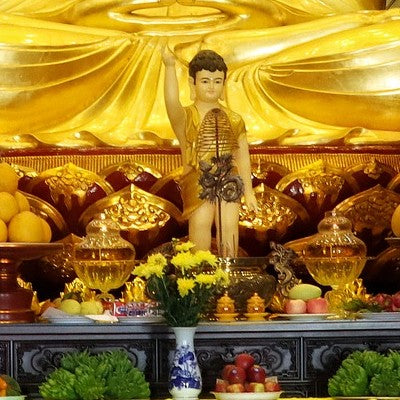Menu
-
-
F.A.Q
- How to identify genuine agarwood chip, natural or cultivated
- How to identify oil injection / absorption fake agarwood beads
- How to know if there are more than one oil in your oil
- How to make your wood bracelet or mala darker
- How to tell if an Agarwood bead sinks WITHOUT sinking it under water?
- How does back flow incense work and how do you burn it?
- Where to start if you don't know what agarwood is ?
- Why are you losing money if you buy seeds and plants?
- Which agarwood incense should I choose?
- Frequently Asked Questions
- Agarwood Related Articles
- Shipping
-
SHOP - Agarwood
-
SHOP - Other Fragrant Wood
-
SHOP - Incense Holder and Burner
-
- FREE Oud Oil guide
- Testimonials
- "Why did you buy this?"
- Contact us
- About Us
- +61430284329
- Login
-
English


The role of Agarwood in Buddhism and how Buddhists use Agarwood
May 17, 2022 6 min read
Table of Contents:[hide]
Agarwood and Buddhism: a brief introduction
Agarwood has been used in Buddhism for centuries as a sacred scent for meditation and prayer. Agarwood is known to have a calming effect on the mind and is thought to help practitioners achieve a deeper level of concentration and focus. In this blog post, we will explore the role of Agarwood in Buddhism and discuss some of the benefits that it can offer spiritual practitioners.
The Sanskrit language poet, Kâlidâsa (c. 353–c. 420), once wrote: Beautiful ladies , preparing themselves for the feast of pleasures, cleanse themselves with the yellow powder of sandal, clear and pure, freshen their breast with pleasant aromas, and suspend their dark hair in the smoke of burning aloes. The word “aloes” has the same meaning as agarwood (Mohamed 2016)
Some Buddhist texts mention using aromatics in religious ceremonies. For example, Agarwood is mentioned in the Jātaka stories, which are based on events that happened around 400 BC. The use of fragrance by women is described in the tale of a King's attempt to enter the realm of the gods through the ritual sacrifice of his most valued possessions, including his family.
The sons were escorted to the sacrificial pit once the offering was completed, and the royal ladies and other female residents of the town clothed in “aloes, sandalwood, costly gems, and silk robes” paid their respects to the son(s) Canda-Suriya before departing for the King's sacrifice (Cowell 1907)
"With earrings, aloes, sandal-wood, in Kāsī silk of costly price,
See Canda, Suriya 1 yonder led as victims to the sacrifice. Piercing their mother's heart with woe, filling the citizens with gloom,
See Canda, Suriya yonder led as victims to their cruel doom.
Bathed and perfumed with richest scents and with white robes of Kāsī drest,
See Canda, Suriya yonder led as victims at the king's behest.
They who once rode on elephants, a gallant sight for every eye,
Our Canda, Suriya yonder see, toiling along on foot to die.
They who in chariots wont to ride, or mules, or horses gold-bedight,
Our Canda, Suriya yonder see, toiling on foot to die ere night."
"With aloes and with sandal decked, wearing rich silks and many a ring,
Go, Canda-Suriya, to the pile, befitting offering for the king. With aloes and with sandal-wood, with silken robes and gems of price,
Go, Canda-Suriya, to the pile, the great king's worthy sacrifice."
Agarwood and Sandalwood, when combined with other precious things, were recognised as a sign of respect and were already utilized as valuable fragrant goods in ancient times.
In the Mahayana Mahaparinirvana Sutra (Nirvana Sutra), aromatics are mentioned in the opening chapter, which covers a series of events and teachings that occurred when Buddha was on his way to Nirvana.

Image by Benjamin Balazs from Pixabay
People used tens of thousands of bundles of fragrant wood to cremate the body of the Buddha. This included sandalwood, aloes (Agarwood), and other types of wood.
Agarwood was also used as fuel in stoves to prepare meals for the Buddha and the Sangha (monks). The Vimānavatthu text is a collection of 85 poems on the happiness of persons reborn in heavenly realms and on the worthy deeds that led to this reward.
There are several references to using fragrances. Sesavati's Mansion (Sesavatītimāna) in poem 35 (7), The Seventh: Sesavati's Funeral Ceremony for the Venerable Captain of Dhamma (Sāriputta), aloe, sandalwood, and other woods were incorporated in a hundred-cubit high (Ireland 2005)
According to Bazin (2013), five natural incense products represented the speech of the five buddhas and included sandalwood, agarwood, pine resin of juniper, camphor, and vetiver root. Fragrant woods have been used in rituals as a symbolic relic or ritual deposit within the cavities of valuable sculptures to make them become sacred objects.
It is clear that fragrant items were an important component of Buddhist culture, with agarwood among the most prized.
How do Buddhists use Agarwood?
The indigenous Tibetan Buddhists burn incense as part of their spiritual sacrifices and meditation practices. They utilise fragrances in monasteries, convents and cloisters for a variety of reasons, which they have studied extensively. Incense-burning fragrances are used as a guide for the soul's journey to enlightenment and as a doorway to the pinnacle of wisdom.
They believe that everyday life is linked to the spiritual, and they use incense burning as a result. Every household burns incense
- to worship Buddha and holy saints,
- preserve their health, and
- ask for blessings on a daily basis.
In the ceremony's preparation, mantras and prayers assist in the burning of incense. In the mornings, they burn incense outside in stone stoves using big branches of juniper, cedar, and sage. Tibetan cloisters use rolled incense sticks to create a distinctive scent that is relaxing, strengthening, and soothing.
The fragrance is very useful and pleasant when living in unheated monasteries during the Tibetan highlands' harsh winter months.
The smoke from the incense-burning plants is regarded holy by the people of the Tibetian region. It protects them from dark forces that may enter the atmosphere and bring illness and bad luck. Almost every home has an altar where people can pray and burn incense no matter how simple and how poor that home is.
The Tibetan Buddhists maintain an incense censer filled with sand in front of the altar and insert incense sticks into the sand. Some people preferred to use incense powder. They use ancient recipes containing sandalwood, myrrh, agarwood, juniper wood, rhododendron, and cedar tips to create incense burning powders.
To worship Buddha
Agarwood is still used in Buddhism today and can be found in many temples and monasteries. It is often used as an offering to the Buddha or placed on an altar to create a sacred space for meditation and prayer. Agarwood incense sticks are also commonly used during Buddhist ceremonies and rituals. The smoke from Agarwood is believed to purify the environment and create positive energy for those who are meditating or praying.
"I have a Buddhist altar in my room. There are several Buddha statues on it. I offer flowers and fruits weekly. I light the incense and place them in the incense censer every day when I say my prayers". NN- a Buddhist

Source: dieukhactrangia
A Buddhist usually hold the incense in front of him when praying. The incense used in worshipping Buddha will usually have a length between 30 cm to 40 cm. With that length, the incense may snap in half easily without a bamboo core. The incense could burn a person's hand if it is lit and breaks in half. With the bamboo core support, a person can hold the incenses securely. The bamboo core incense makes it easier for him to place the incense in the incense censer.

The Spiritual Communicator Agarwood incense is perfect for use on a Buddhist altar. The light woody scent makes your place feels like a holy place. These incense come in a convenient bamboo core style, making it easy to use. You can lean more about this bamboo stick incense here
Dharma talk is a formal lecture on Buddhism given by an Abbot to students. The talks can be about any aspect of the Buddhist scriptures, ways of lives to meditative practices. These talks can be several hours long. Therefore, the host needs to keep the audience happy and comfortable. In these sessions, a Buddhist host will organise fresh flowers and prepare light meals to refresh his guests. Burning Agarwood chips is one way to create a pleasant atmosphere. This woody aroma is appreciated at Buddhist Dharma talks as it is said to have a calming effect that helps listeners focus on Abbott's words.
To pray to Buddha, chant Buddhist scriptures and meditate
Agarwood is also used to make Buddhist malas (prayer beads). The 108 beads on a mala represent the 108 earthly desires that humans have.
When reciting mantras, along with burning Agarwood incense, a Buddhist can pray with a mala in his hand.
"I use my Agarwood mala beads every day. I start at the guru bead and recite the mantra 108 times. The Agarwood incense helps me to focus on my chanting and connect with the Buddha" - A Buddhist practitioner.
Agarwood is a popular material used in Buddhist rituals and practices. Its calming scent is said to purify the environment and create positive energy. Agarwood incense. By chanting with a mala, Buddhists believe they can purify their desires and attain enlightenment. Agarwood is said to have a calming and grounding effect, which makes it ideal for use in meditation.
In short, whether you are using Agarwood for its sacred scent or its healing properties, this beautiful wood has a lot to offer. If you are looking for a special gift for a Buddhist friend or loved one, Agarwood is a considerate choice.
Leave a comment
Comments will be approved before showing up.
Also in News

What is Tasbih? The Deep Meaning of Subhan Allah and the Role of Prayer Beads
November 09, 2025 4 min read



